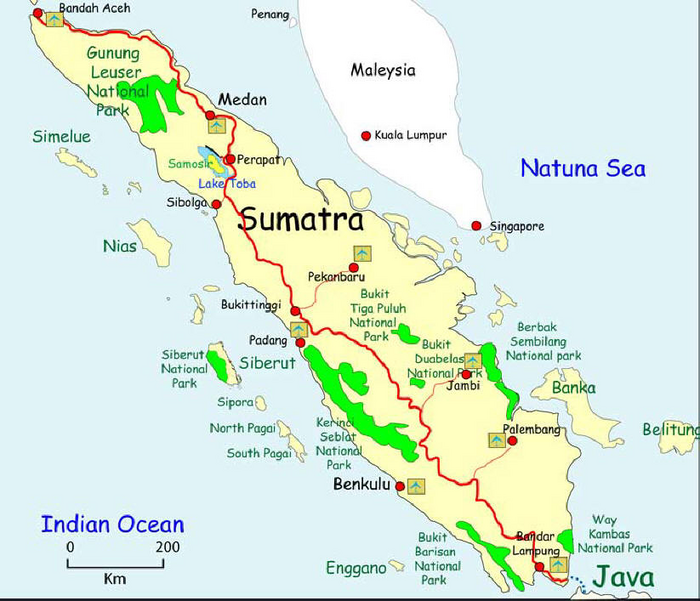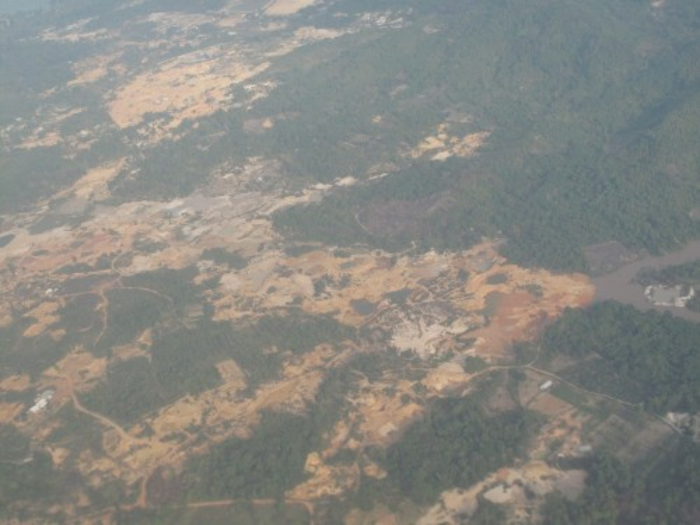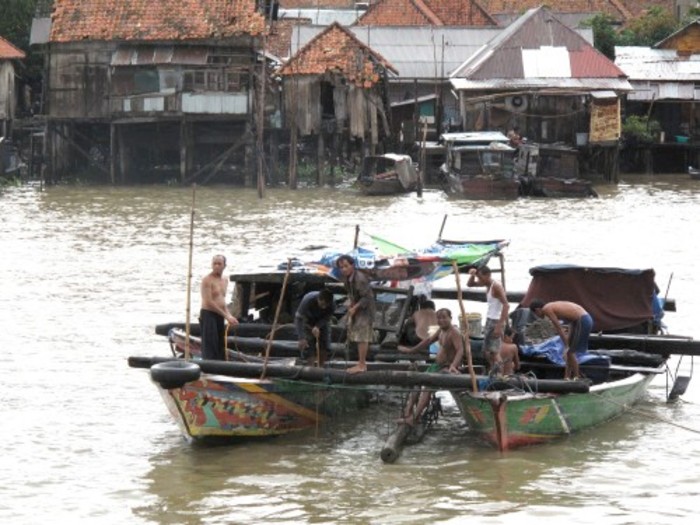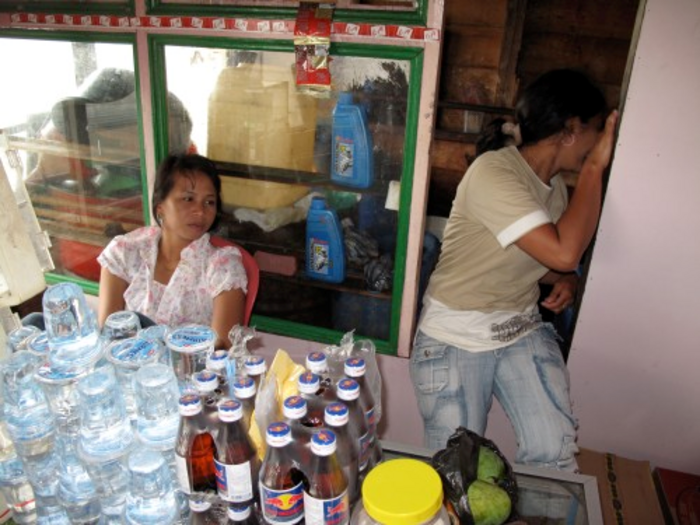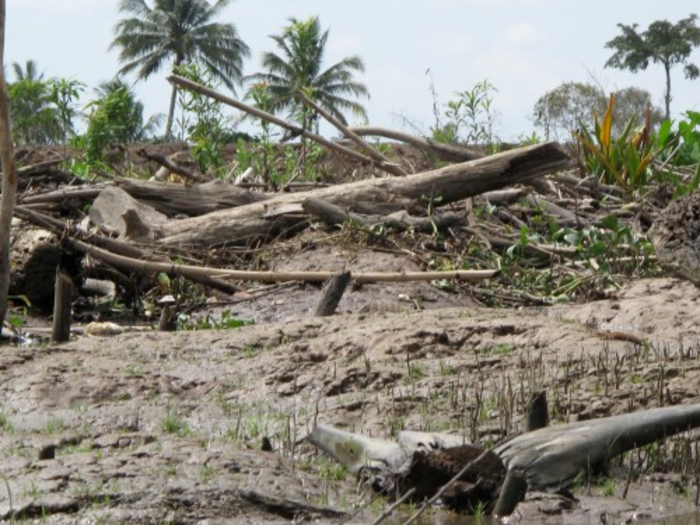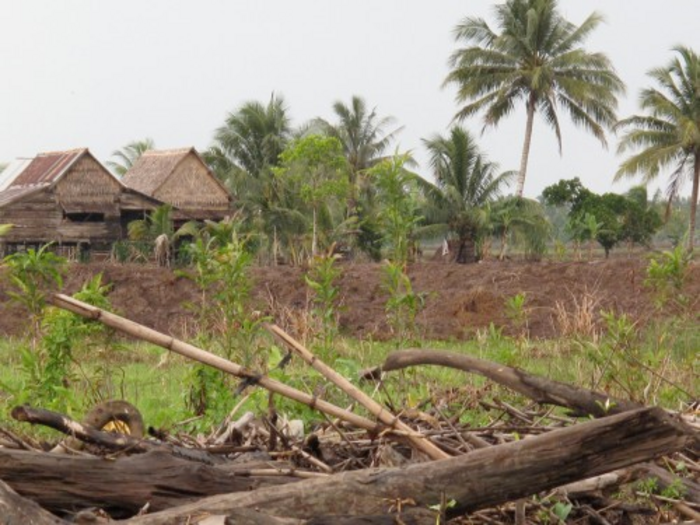In the Tropical Forests of Sumatra: Notes from Climate Change ‘Ground Zero’ [Abbreviated Chinese translation available]
Andre Vltchek from Palembang, Musi River and Bangka Island
Introduction by Geoffrey Gunn
It is probably a cliché to observe that tropical rain forests host the greatest known concentrations of bio-diversity on the planet. Together, the three great global equatorial biozones are central Africa, the Amazon basin, and the Indonesian archipelago, including southern Sumatra Island, and the even more remote tin-rich offshore island of Bangka, as profiled here by Andre Vltchek. Recent understandings also point to these dramatically shrinking forest reserves as carbon soaks and/or as the planet’s treasured green lungs.
Indonesian rain forest
Distantly known to the ancients, as in early Ptolemaic representations, Sumatra was also visited by travelers, traders, and monks plying the maritime silkroads between India and China. As confirmed by recent archeology, Palembang, on the banks of the Musi River in southern Sumatra, was also the capital of the ancient Buddhist kingdom of Srivijaya, standing at the core of this ancient trading system athwart the Malacca Straits. In fact, all the major river systems on Sumatra and across the Straits hosted Indianized settlements suggestive of an earlier golden age. Practically nothing of these ancient civilizations remains today, just as massive sedimentation has extended the coastline of Sumatra, leaving modern cities like Palembang far upstream with the lower reaches of the rivers flowing through extended mangrove forest environments. No doubt exploding volcanoes, earthquakes and tsunamis added their geomorphological impacts. Humans have had to adapt to this changing coastal riverine environment.
Vltchek remarks upon various human settlements along the Musi River. Until the recent past, a substantial percentage of Palembang residents resided in extended “water villages.” The maritime and the settled have always been in flux in this environment, especially as harvesting the river and coastal waters is still a major source of livelihood across the archipelago. The ravages of nature aside, we can believe that with lower density populations living in simpler times, a strict human-nature balance existed in this kind of environment, or what today would be described as a resource-management model or sustainable forms of livelihood/development.
But Vltchek also draws attention to a pockmarked denuded landscape on offshore Bangka Island and we do not doubt his explanations. Still, it is intriguing that Bangka’s lucrative tin deposits attracted pioneer miners from China dating back even prior to Dutch colonization. As on western Kalimantan (Borneo) Island, Chinese immigrants also introduced hydraulic sluices and other Chinese technologies, undoubtedly transforming the landscape for the worse. But the tempo of environmental change in southern Sumatra was also abetted by Dutch colonization. Notably, the exploitation of Sumatra’s riches kicked off, as with oil exploration, the modern exploitation of Bangka’s tin, and the recruitment of Javanese to supply export labor in Sumatra’s tea, coffee and rubber plantations. The Exxon-Mobil Stanvac oil refinery opened in 1926 (demolished ahead of the Japanese invasion) and sited beside the Musi River is one legacy of this earlier wave of foreign investment.
Having spent several weeks on the Musi River during the second year of the Indonesian New Order regime of President Suharto (1968), I have a mental picture of a river system that more closely approximates the sustainable development model (some would argue, benign neglect model) as underwritten by Indonesia’s first president, Sukarno, who, not only nationalized Dutch investments but, famously, told Washington to “go to hell” with your foreign aid. For sure, the Musi River and probably other rivers of Kalimantan and Sumatra were choked with rotting vegetation and other natural flotsam. No doubt, as well, the city and the Stanvac refinery added to river pollution. But, this was in an era prior to the wholesale plunder of the archipelago by the New Order regime, including its infamous military linked companies.
Today, as Vltchek vividly describes, this once pristine wilderness is subject to the predatory actions of agro-business interests, resulting in unbelievable desecration of the environment. Added to that, the deliberate burning of forest to open land for oil-palm plantations, might have gone unnoticed in regional capitals and the world were it not for the famous “haze” or smoke pollution which drifted into Singapore, Kuala Lumpur, and Brunei in the early to mid-1980s, shutting airports and schools.
To be sure, then as now, as Vltchek evokes, the Musi River has a central African – more accurately – Conradian quality (Bangka island was reputedly the setting of Conrad’s Lord Jim), just as the modern chaotic Palembang in the tropical torpor presents an uninviting even pestilential side. Arriving at the mouth of the Musi River aboard a (traditional) Chinese vessel, my craft was greeted with a cannon shot across – or aimed at – the bows, the flash and thunder signaling a half-hidden customs house buried behind a mangrove forest, itself shrouded in early morning mist rising from the river. Whether or not preying upon passing vessels was a Suharto-era practice or one kicked off by the passage of Chinese fleets reaching back over the millennium, I don’t know, but it was obviously lucrative given the procession up and down the river by a profusion of native craft, from rafts to Buginese prauhs, alongside motor launches, ocean going liners and tankers.
In any case, returning to the resources-management theme, we also wonder whether or not part of the cost of equatorial forest management should be borne by first world consumers of tropical hardwood alongside oil palm products which include soap and cosmetics. This is not an original thought, but as Third World critics have strongly argued in run up to the COP 15 environmental conference, it is surely part of the solution alongside better local governance, transparency, and public education that are obviously in short supply in the locales described in the body of this article. GG
Tin mine pits are like enormous open wounds dominating the landscape of island Bangka, near Sumatra and only 40 minutes flight from the Indonesian capital – Jakarta. Even from the air it is obvious that the island is a textbook example of man-made environmental calamity. Only a few tiny pockets of natural forest remain, surrounded by rubber and palm oil plantations.
En route from the airport to the Eastern part of the island, our driver explains diffidently, “Mining companies don’t give much back to this island. The government built one decent hospital here. But that’s about it and the people have no say about what happens on this island.”
The island of Bangka, home to around 650,000 people, is known for its white beaches, but those are now covered by garbage and basically unusable for tourism. Most of the beaches exhibit the latest ‘cultural trend’: more affluent young people and families bring their cars and scooters to the seafront and drive back and forth on the sand, until late evening hours. Silence – once the last attraction of the island – is gone, replaced by the roar of engines. The beach decorated by some fantastic rock structures is now badly polluted.
Bangka from the air
Just a few miles across the sea from Bangka, a dilapidated hydrofoil (one of which recently sank) enters the magnificent Sungai Musi – one of the mighty rivers of Sumatra Island. While I was admiring the surface of the river from the boat, a local student suggested that I look between the trees separating the riverbank and the interior: “Try to catch the moment – the opening. You will see – there is nothing left of the forest.”
One hour later, this black smoke and pop-music belching craft docks at the port of the city of Palembang.
Brown waters of the Sungai Musi
With 1.5 million inhabitants, Palembang is the second largest city of Sumatra and one of the most populous in Indonesia. It is one of the most appalling urban centers on the Asian continent with hardly anything to offer except for a handful of Dutch-era buildings and several picturesque traditional houses on stilts inhabited by the very poor. The city’s entire social life centers on the enormous French Novotel hotel built like a fortress, with adjacent shopping mall nearby. Although located some 80 km from the coast, Palembang is a vast seaport with huge vessels docked at the banks and in the middle of the Musi River. The river and the streams that feed into her are not just polluted – they appear to be positively toxic.
Dwellings by the water in Palembang
Inflated carcasses of dogs and other animals are sailing on the surface of the river, together with industrial waste, debris, bottles and simple household waste. Despite its size, Palembang – like almost all Indonesian cities – has no public transportation, except corroded and polluting minivans and a few decomposing buses. Palembang is home to oil refineries, as well as cement and fertilizer plants. It sits in the middle of two major areas of unbridled deforestation on the Island of Sumatra. While Indonesia is often referred to as Ground Zero of climate change, Palembang should be considered one of its most telling monuments.
Isna Wijayani Lexy is Professor of journalism at the Faculty of Social and Political Science – Communication Department, University Baturaja, Sumatera. Hers is one of the few outspoken voices in this part of the world:
“Illegal loggers can usually count on backing from the police, military, local government officials and thugs. Media only cover raids against the loggers, that is, if there are raids. Even then it is very rare that journalists cover them on their own, as they are usually short of funds and can’t just go up or down the river as they please. On this as well as many other topics, there is news hegemony and no diversity in contents. The local journalists dare not take risks. Journalists in Palembang only look for easy news and if they have been ‘serviced’ (bribed), bad or critical news will not be published. Money talks here, even when it comes to the news.”
Logging is considered a ‘very dangerous topic’ to cover and the local press would never dare to go into uncomfortable details. It is widely known that police and the military are involved in lucrative illegal logging operations.
There are plenty of alarming reports by local academics and international observers about the archipelago’s disappearing rainforests and unbearable pollution levels in all major Indonesian cities. But there are few sound analyses that link all the factors that make Indonesia environmentally one of the most battered nations on earth: corruption, government incompetence, powerful position of armed forces and unbridled pursuit of profits utilizing the easiest and often non-sustainable means.
Restraint was broken when The Jakarta Globe reprinted on January 29, 2010 an Agence France Press report: “The Indonesian military is deeply involved in the trade in illegally felled timber that is destroying vast tracts of pristine forest and contributing to global warming, researchers said Friday. The report comes days after the government revealed plans to ask foreign governments to contribute to a billion-dollar “green investment fund” to help it cut greenhouse gas emissions through sustainable infrastructure projects. Environmentalists argue that the government could go a long way towards meeting its target of cutting emissions by 26 percent from 2005 levels by 2020 simply by stopping rampant, unchecked illegal logging. But the new study by the Center for East Asia Cooperation Studies (CEACoS) at the University of Indonesia has revealed how difficult this could be given the military’s involvement in the illicit trade. CEACoS executive director Tirta N. Mursitama, the head researcher in the project, said the military acted as a coordinator, investor, facilitator and middleman for the illegal loggers…”
The Report centers on the forest bordering Malaysia in East Kalimantan/Borneo, but the situation is similar in the rest of the country, including Sumatra.
Given the combination of state controls and the silence of the media, the public remains largely uninformed about the environmental and social disasters that are devastating their country.
Despite pollution, the River Musi is still one of the mightiest waterways of Southeast Asia. The misery along this waterway is on a par with some of the poorest parts of Africa. Tiny villages and towns along the shores are lost in time – often cut from the rest of the country.
Upang town is built on stilts. It is an expensive one-hour boat ride from Palembang at breakneck speed. Speedboats between Bangka Island and Palembang don’t stop here. The town survives by supplying riverboats with fuel and food. Children can study only until the 9th grade – the closest high school is in Palembang, therefore unreachable for the great majority of inhabitants.
Upang sits in the middle of illegal logging on Musi River.
Two young girls – Linda and Yanti – are working in a warung (local eatery) on stilts.
“Each household has people who work across the river on ‘cleared land’”, explains Linda who has no idea how many households there are in Upang. “People from the entire area are working on ‘cleared land’, many doing the ‘clearing’ itself. There are no permits necessary and no taxes; nobody checks.”
Suddenly it starts to rain. The sound of the tropical downpour is overwhelming as it strikes the metal sheets of the roof. Old cargo boats on the river suddenly look like phantoms and the other shore disappears from sight.
The girls explain that their monthly income is Rp 20.000 to 30.000, approximately US$2 to US$3 at the present exchange rate.
“Here we only wait for the weddings”, explains Yanti. “At least something happens during the wedding. There is music and food. My dream is to become rich. If I were rich, I would give alms (zakat) and then travel – I would go to Bandung and to Jakarta. I would visit the National Monument.” Neither girl had ever left Upang – not even to visit Palembang, 25 miles up the river.
The girls had no knowledge about deforestation. They knew it only as ‘clearing the land’, something good for planting rice and palm oil. Global warming – no idea what it is. We asked the same question of several people along Musi River and we always received the same answer –incomprehension and bewilderment on their faces.
Rural Indonesia is extremely poor and underdeveloped – moral and ethical questions here are simply perceived as odd. Caring for the environment and the world are luxuries most impoverished Indonesian can’t afford, while for the rich rulers of this nation they are simply not profitable enough.
Before leaving, we asked the girls whether they vote; whether they participate in what the West calls ‘the third largest democracy’.
“We have no interest in politics”, said Yanti. “We voted for some party, but we don’t remember its name. We decided whom to vote for based on the photos; we voted for Nurdin because he is handsome and we both voted for the same person. Why did we vote at all? Well, they gave us election card, so we did. It gave us at least something to do that day.” Their response is illustrative of the torpor of Indonesian politics, with multiple indistinguishable parties, and widespread political apathy.
Sailing across the river and then slowly progressing towards Palembang, the full horror of deforestation suddenly emerges. Hundreds of square miles of rain forest destroyed and replaced by tremendous bare plains; some areas still burning. There are bags with chemicals and bottles of spray scattered all over the earth. Even for those who are not experts on the environment, this could hardly appear as anything else then unbridled, gross and brutal rape of the nature.
As the banks of the river are slightly elevated, it is not easy to see the onslaught against the forest – it is necessary to enter one of the small lagoons by boat and then find one’s way through the swampy banks in order to see the scale of the devastation.
New crop after forest devastation
At one of the epicenters of disaster, at Sawah Upang, we spotted an old couple sitting in front of their house. They waved and happily explained their presence here: “We are from Palembang. Five years ago we bought the land here from other people from Upang. Now we have our rice fields here.”
Upang
Deforestation? Global warming? – They both smiled, not comprehending.
On the way back to Palembang it began to rain and this time the rain was heavy and continuous. Huge rusty cargo ships once again stood in the middle of the river like some tremendous ghosts, while the factory chimneys regurgitated colorful smoke skyward, even in this heavy downpour, Streams brought to the river brown and foamy liquid. All around was misery, dirt and hopelessness – so common in today’s Indonesia but here somehow brought to the extreme.
Indonesia has achieved the world’s fastest rate of deforestation, with an area the size of 300 soccer fields every hour. According to Greenpeace: “Of the 44 countries which collectively account for 90 percent of the world’s forests, the country which pursues the highest annual rate of deforestation is Indonesia with 1.8 million hectares (4.4 million acres) of forest destroyed each year between 2000-2005.”
The country has already lost over 70 percent of its intact ancient forests and half of what is left are threatened by commercial logging, forest fires and clearances for palm oil plantations. And the greed seems to know no boundaries.
No matter how pressing, the environmental issues can’t be separated from the general and continuous decay of Indonesian state – from its endemic corruption, impunity of armed forces, extreme breed of market fundamentalism and faith put above rational thinking.
Andre Vltchek – novelist, journalist and filmmaker, wrote and photographed this article. An Asia-Pacific Journal associate, he is presently living and working in Asia and Africa and can be reached at [email protected]. He is co-editor with Tony Christini of Liberation Lit, a landmark collection of art and criticism of social change, including contemporary liberatory fiction and criticism, poetry and visuals, and co-author with Rossie Indira of Exile: Conversations with Pramoedya Ananta Toer. His homepage and blog can be accessed here.
Geoffrey Gunn is author of Singapore and the Asian Revolutions, 2008 and an Asia-Pacific Journal coordinator.
Recommended citation: Andre Vltchek and Geoffrey Gunn, “In the Tropical Forests of Sumatra: Notes from Climate Change ‘Ground Zero,’” The Asia-Pacific Journal, 7-2-10, February 15, 2010.





